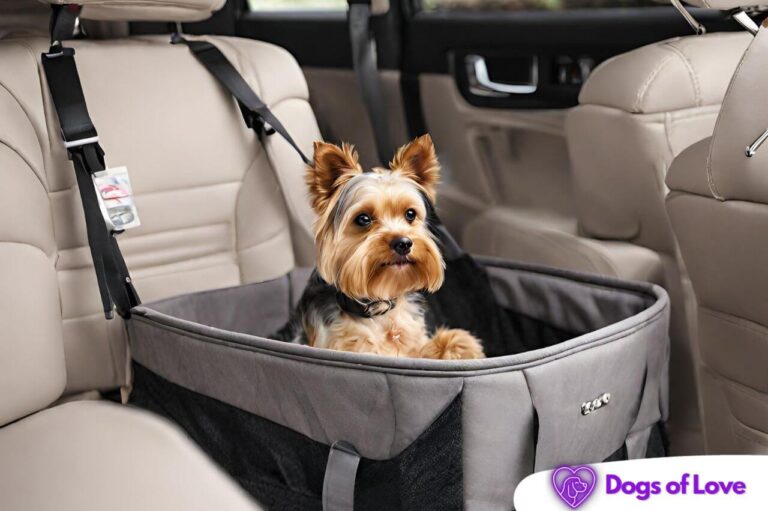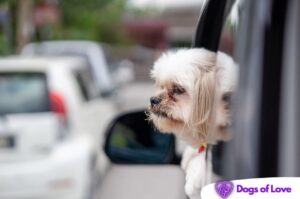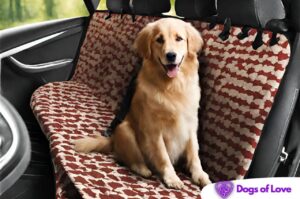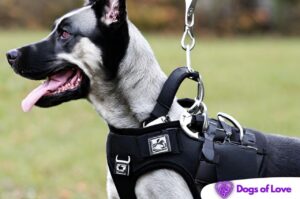Whether a dog should sit in the front or back of a car seat is an essential consideration for pet owners prioritizing their furry companion’s safety and well-being during car travel.
The choice ultimately hinges on various factors, including the dog’s size, behavior, the type of vehicle, and the presence of airbags.
Each position has advantages and potential risks, making it essential to assess the circumstances and make an informed decision to ensure a secure and comfortable journey for both the pet and the passengers.
In this discussion, we will explore the benefits and considerations of both options to guide pet owners in making the right choice based on their specific needs and circumstances.

What are the Pros and cons of having your dog ride in the front of a car seat?
Having your dog ride in the front of a car seat has pros and cons.
On the positive side, having your dog in the front seat allows for closer interaction and monitoring, ensuring their safety and comfort during the ride.
It can help alleviate anxiety for both the dog and the owner, as the dog can see and be reassured by their owner’s presence.
Additionally, the owner can quickly respond to the dog’s needs, such as feeding, comforting, or attending to any signs of distress.
However, there are notable cons to this arrangement as well.
In the event of an accident, the airbag in the front seat can pose a severe threat to the dog’s safety, potentially causing injury or even death.
Also, the dog’s presence in the front seat can distract the driver, compromising the overall safety of the journey.
It’s essential to weigh these pros and cons and consider alternative, safer options for traveling with your dog in the car.
What are the Pros and cons of having your dog ride in the back of a car seat?
Having your dog ride in the back of a car seat has pros and cons.
One of the significant advantages is safety.
Placing the dog in the back reduces the risk of injury from airbags, typically in the front.
It also minimizes distractions for the driver, contributing to a safer driving environment.
Moreover, the back seat provides more space for the dog to move around, lie down, or even be secured using a proper restraint system, enhancing their comfort during the journey.
However, a potential downside is reduced monitoring and interaction compared to having the dog in the front seat.
It might also cause anxiety for some dogs, especially those prone to car sickness or fear of being separated from their owner.
Overall, balancing safety and the dog’s well-being is crucial when deciding where in the car your dog should ride.
What are the Benefits of restraining your dog while driving?
Have you ever taken your furry friend for a ride in the car?
If so, you know how easily they can get distracted.
Dogs are curious creatures, wanting to sniff every scent and investigate every new experience.
While this can be charming during walks in the park, it can be downright dangerous when you’re behind the wheel.
By restraining your dog while driving, you not only reduce distractions for yourself, but you also protect your beloved pet.
A restraint can prevent your dog from jumping onto your lap, interfering with your gear shift, or climbing out the window.
By restraining your dog in the back seat of the vehicle, you’ll be glad you did when you can focus entirely on the road without worrying about your pup’s safety.
What are the Different ways to keep your pup safe when riding in the backseat?
There are several effective ways to ensure your pup’s safety when riding in the backseat of a car.
Firstly, utilizing a proper dog restraint or harness specifically designed for car travel is essential.
These restraints secure your pup in place, preventing them from moving around or being thrown in case of sudden stops or accidents.
Additionally, consider using a dog-friendly car seat or a booster seat that provides a secure and elevated position for your pup, allowing them to see outside and reducing the risk of injury.
Another measure is to use a sturdy barrier or dog crate to create a safe enclosure in the backseat, limiting their movement and potential distractions to the driver.
Additionally, consider using a backseat pet barrier to create a physical barrier between your dog and the front seat, preventing distractions and ensuring everyone’s safety.
Lastly, ensure proper ventilation, a comfortable environment, and frequent breaks for your pup during long journeys to keep them calm, relaxed, and safe.
So, in the opinion of experts, sitting the dog in the back of the car is the best?
In the opinion of experts, placing the dog in the back of the car is often considered the best and safest practice.
This location minimizes potential distractions for the driver, promoting safer driving conditions.
It reduces the risk of injury that could result from airbags deploying in the front seats, which can be harmful to dogs.
Moreover, the backseat provides more space and a controlled environment for the dog, allowing for the use of safety harnesses, seatbelt attachments, or travel crates to keep them secure during the journey.
While close interaction may be limited compared to having the dog in the front seat, the priority is ensuring the dog’s safety and comfort throughout the ride.
However, it’s important to note that the best approach ultimately depends on the specific needs and characteristics of the dog, as well as adherence to local laws and regulations regarding pet travel in vehicles.
In conclusion
Whether a dog should sit in the front or back of a car seat depends on various factors, each with its own considerations.
Placing the dog in the back of the car is generally viewed as a safer option, minimizing potential risks associated with airbags and distractions for the driver.
It allows for better restraint using harnesses, seatbelt attachments, or travel crates, ensuring the dog’s safety during the journey.
On the other hand, placing the dog in the front seat can foster closer interaction and reassurance, but it comes with risks, particularly concerning airbag deployment.
Ultimately, prioritizing the dog’s safety, considering their comfort, and adhering to local laws and safety regulations should guide the decision-making process.
Each dog and situation is unique, warranting a thoughtful approach to ensure a safe and enjoyable travel experience for the dog and the vehicle’s occupants.








